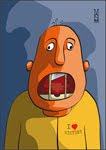Danubiana
Quite regularly I am getting questions from abroad: What atractive places could you recommand to visit in your city? Searching for an answer always brings a few unpleasant questions. I turned for an answers to a friend of mine: Why should turists visit our country? Or more precisly Bratislava? Why should they travel hundreds or thousands of miles to come here? My friend reacted: To take a photo of some historical buildings in our little Old Town and some of the kitshy sculptures.
So I try to find an answer myself: What could become an attraction for curious fellows from abroad? Devin Castle? Bratislava Castle? Cumil? The Botanic Gardens? Sitina Tunel? Apollo Bridge? Gallery by Danube River? Sand beach at Janko Kral Park? Artificial skating-rink at Hviezdoslav Square? A new Slovak National Theatre? New supermarkets?
Perhaps everyday life made me insensitive to finding outstanding objects in our dynamic city. Or prhaps I know little about it. Well, our Wienislava does not seem so atractive to me. Cheap and funsy things make no impression on me. On the contrary the places I like do not belong to turists top atractions but I like them for other reasons.
One of these is a Museum of Modern Art Danubiana in Čunovo. I can’t really explain why I feel so good when I’m there and why I keep coming there. I rather share with you some photodocumentation.
It was opened on 9th September 2000 about 15 kilometres south of the centre of Bratislava, on the edge of a peninsula where the Danube flows. It is one of the youngest museums of modern art in Europe and it is really cool place.
Here is the situation on the map.
And here is the place itself.







More here.
PS: When I visited Danubiana last time, there was exhibition of artwork of painter, poet and photographer Lucebert. Except of that he was involved in drawing, graphic art, ceramics, wall painting etc, so it looks his fingers were dip in every possible asshole. Anyway, here are three paintings I really liked.


































